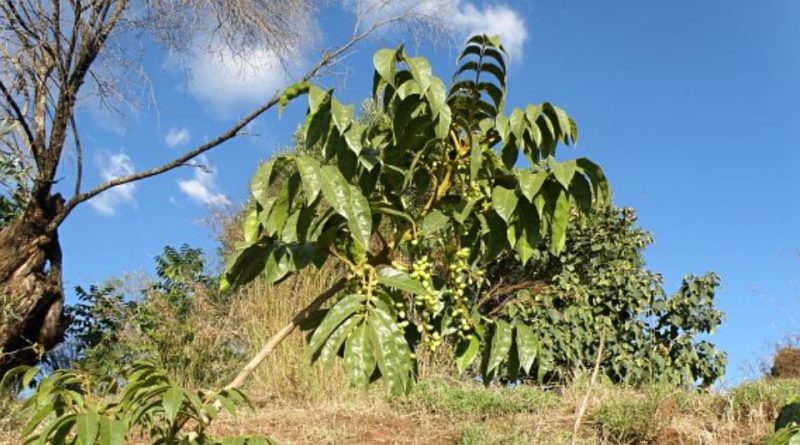Brucea ferruginea
Brucea ferruginea
Brucea (Brucea ferruginea L’Hér.) Is an arboreal species belonging to the Simaroubaceae family.
Systematic –
From a systematic point of view, it belongs to the Eukaryota Domain, Plantae Kingdom, Magnoliophyta Division, Magnoliopsida Class, Sapindales Order, Simaroubaceae Family and therefore to the Genus Brucea and to the Species B. ferruginea.
The terms are synonymous:
– Brucea abyssinica Spreng.
– Brucea antidysenterica Lam .;
– Brucea salutaris A. Chev ..
Etymology –
The term Brucea was given in honor of Miss E.M. Bruce who herbized in Tanzania in 1934-35.
The specific epithet ferruginea comes from ferrum ferro: ferrugine, brown-red, rust-colored.
Geographical Distribution and Habitat –
Brucea ferruginea is a plant native to tropical Africa where it is found in Angola, Cameroon, Central Africa, Congo, East Africa, Eritrea, Ethiopia, Guinea, GuinŽe, Malawi, Nigeria, Sudan, West Africa, Zambia.
Its habitat is that of evergreen forests, edges of forests and secondary shrubs; in Africa it grows at altitudes between 1400 and 2800 m.
Description –
Brucea ferruginea is an evergreen tree that grows to a height of 5–10 (–15) m.
The bark is smooth, gray or brown in color, with rust and pubescent buds.
The leaves are alternate, pinnate, 10–65 cm long, mostly rusty and hairy and often almost sessile.
The inflorescences are similar to spikes, 5–35 cm long, bearing numerous male or female and bisexual flowers 4 (–5); in male flowers there is a circle of stamens; the gynaeceum is made up of 4–5 free fruiting bodies. Behind the fruit, a cotyledon similar to grapes is formed, the individual fruits are ellipsoidal, 9-14 mm long, red when ripe.
Cultivation –
In its habitat, the plant usually grows at 2,500 meters a.s.l. but exceptionally it can go up to 3,700 meters in the areas of the humid tropics of Africa.
Vegetative growth, flowering and fruiting continues throughout the year, even in the dry season.
It prefers moist soils and areas in full sun or even semi-shade.
For propagation the best method is to sow directly in situ. Seeds can be stored at room temperature for over a year.
An alternative method of propagation is the transplantation of plants grown in the wild.
Brucea ferruginea is a host plant of the Mediterranean fruit fly, an important pest in the fruit industry.
Uses and Traditions –
The name of this species, in the form of the synonym Brucea antidysenterica, indicates the healing properties of this plant for the treatment of dysentery.
Furthermore, a beneficial effect of this substance on the inhibition of various types of cancer (leukemia, melanoma) has also been demonstrated.
The leaves and bark have powerful anticancer properties and have attracted a lot of research attention in recent decades.
Some studies have been inconclusive, while others have shown promising results, above all because the effects have been facilitated by the absence of manifest toxicity. In addition to their antineoplastic activity, many compounds present in the plant are highly effective against the amoeba that causes dysentery, the Entamoeba histolytica and the malaria parasite Plasmodium falciparum.
The quassinoids present in the plant have shown weak anti-tuberculosis activity in vitro, while their anti-HIV potential has been cited by high cytotoxicity.
The quassinoids are characteristic of the Simaroubaceae; they give the Brucea bark a characteristic bitter taste.
The alkaloids present in the bark of the root of Brucea ferruginea, therefore, have anticancer and antimicrobial properties.
Wounds and skin ailments, such as those considered by leprosy and scrofula, are treated with ointments based on leaves and twigs mixed with clarified butter or butter, or with ripe fruits mixed with honey.
Root preparations are used on sores caused by sexually transmitted diseases, while leaves and seeds are used to treat skin cancers.
The roots are used to cure anger.
The fruits contain about 22% of oil. A yellow dye is obtained from the endocarp. Timber is used as firewood and for roof construction.
The fruits are bitter and, reportedly, toxic to livestock, especially sheep. The bark is used as a bitter aroma.
Finally, calcium oxalate crystals are present in the bark, leaves and roots.
Method of Preparation –
The bark, fruits, seeds, leaves and roots (sometimes boiled) are used as a remedy for diarrhea, indigestion and stomach pain.
The leaves and roots are cooked with meat or infused with milk (for children) to relieve asthma.
Guido Bissanti
Sources
– Acta Plantarum – Flora of the Italian Regions.
– Wikipedia, the free encyclopedia.
– Treben M., 2000. Health from the Lord’s Pharmacy, Tips and experiences with medicinal herbs, Ennsthaler Editore
– Pignatti S., 1982. Flora of Italy, Edagricole, Bologna.
– Conti F., Abbate G., Alessandrini A., Blasi C. (edited by), 2005. An annotated checklist of the Italian vascular flora, Palombi Editore.
Warning: Pharmaceutical applications and alimurgical uses are indicated for information purposes only, they do not in any way represent a medical prescription; therefore, no responsibility is accepted for their use for healing, aesthetic or food purposes.


